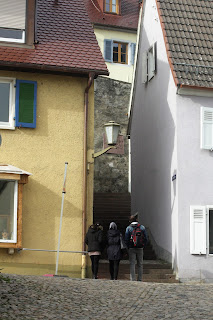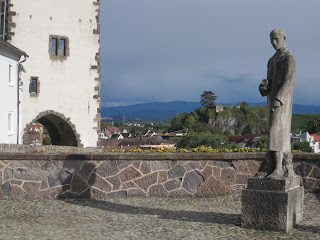
In this old carved map you can see the town from a similar perspective and how it had clearly been situated from Roman times as a place to both take advantage of and control the river traffic.

Our view after we exited the ship and walked along a shoreline path was more like this.

We proceeded up a residental street past lovely homes with beautiful yards. This one had a lovely garden and a striking water feature.
In another block or two we reached a busy market square. We quickly realized that some kind of a festival was going on. A number of cafes were crowded, music was playing, and hefty steins were being hoisted.
We were tempted to stop for some liquid refreshment, but the cathedral mount was still above us and we pressed on toward our goal.
So up we climbed.

Finally we passed through an old whitewashed tower that led on to a small small viewing area.
There was not another soul there and we paused a while to catch our breath and take in the view.
From below you can tell that it was part of the old medieval city walls.
Meanwhile,, back up in the viewing ares, we were enjoying great views over the town. We could look back at the market square cafe where we had started our climb. We could still hear the music playing somewhere down below in the town.
We looked across the town to a hill in the distance where the ruins of another ancient fortress appeared.

We could even see our ship nestled in its mooring just off the main river.
After our little respite to catch our breath, we still had some climbing to do to reach the church.

While we trudge upward let me share with you a few details about St. Steven's Cathedral. I know it's easy to get churched out when touring Europe, but I found a special quality in this one because it took some effort for a pair of old folks to reach it.
St. Steven's was built on a volcanic cliff that by 260 AD already held a Roman fortress. The cathedral of today, like so many of these edifices, is a product of multiple changes and re-buildings over time. It was started in the Romanesque style in the 1100's, but by the 1300's had a Gothic style high choir. If you look at the 19th century print below, you can easily see the little watch tower arch on the left just below the church. The viewing plaza I took the pictures from is just to the left of the little gatehouse and behind that you can just see the gentle hill that descends toward the summit where the church stands.

That final path now leads you to the undercroft at the rear of the current church where a huge central pier still supports the whole center of the Gothic Choir above it..

We also must note that Breisach was heavily bombed during WW II and the church as well as much of the town was left in ruins. Below is a print from 1945 showing the state of the building before its restoration. There are still some old shell marks on the current walls. Rebuilding was not completed until the 1960's. and
restoration continues to this day as exterior carvings are replaced.
Photography was not allowed inside so I bought a small illustrated book that had some illustrations in it. This is the nave looking down toward a magnificent carved rood screen. Behind the screen is a simple altar backed by a carved wooden altarpiece that is among the finest in all of Germany.


In sum we were exhilarated by our serendipitous excursion to St. Steven's Cathedral. It was a beautiful spot and the effort to make the climb made it all the more fulfilling.
To top off the late afternoon off, as we exited the chancel, we heard strains of the Beatles "Here Comes the Sun." echoing faintly up from somewhere down in the town. What a finish to a nearly perfect day!
There was a spring in our step as we headed back to the river for a well deserved cocktail in the lounge followed by a delicious dinner and some pleasing pinot grigio.
Ahoy you hearties. Make the climb if you can.
On the river again tomorrow. Join us!



















No comments:
Post a Comment